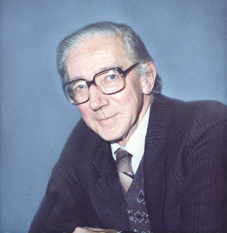George Edward Hughes facts for kids
George Edward Hughes (born June 8, 1918 – died March 4, 1994) was a smart thinker from Ireland who later lived in New Zealand. He was a philosopher and a logician, which means he studied big questions about life and how we think. He was especially known for his work on modal logic and old ideas from the Middle Ages.
About George Edward Hughes
George Edward Hughes was born in Waterford city, Ireland, on June 8, 1918. His parents moved to Scotland when he was young, around the early 1920s. This happened because of the Irish War of Independence.
George studied at the University of Glasgow, where he earned top grades in Philosophy and English. He then spent a year studying at the University of Cambridge. After that, he returned to Glasgow to teach.
He also taught at universities in Wales, including Cardiff University and Bangor University. In 1951, he moved to New Zealand. There, he became the first professor of Philosophy at the Victoria University of Wellington. He worked there until he retired in 1984. George Hughes passed away in Wellington on March 4, 1994.
His Work and Ideas
Many important thinkers influenced George Hughes. These included John Wisdom and Ludwig Wittgenstein, whom he learned from at Cambridge. He also learned from J. L. Austin, who studied how we use everyday language. Later, he met Arthur Prior in New Zealand, and they found they had many similar ideas.
George Hughes was a very good teacher. Students and colleagues respected him a lot at Victoria University. People remember him for always wanting clear answers and for being honest and kind.
Logic and Philosophy
Early in his career, George was interested in ethics (what is right and wrong) and the philosophy of religion. But he became most famous for his books on modal logic. He wrote these books with his colleague and former student, Max Cresswell.
In 1968, they published An Introduction to Modal Logic. This was the first modern textbook on the subject. This book helped many students and researchers learn about Kripke semantics. This is a mathematical way to understand meaning in logic. It changed how people studied modal logic. It even helped with things like understanding natural languages and how computer programs work.
Another special interest for George Hughes was medieval philosophical logic. He worked on explaining old Latin writings by thinkers like Jean Buridan and Paul of Venice. He also translated these old texts into English.
Other Interests
George Hughes was also a priest in the Anglican Church. He became a priest in 1950 at Bangor Cathedral. At that time, churches in Wales needed priests who could lead services in both Welsh and English. George was good at languages, so he quickly learned how to say the Welsh words for the service, even though he didn't speak Welsh fluently.
He was married and had five children. His wife, Beryl Hughes, was an historian. She taught at Victoria University for 25 years. She also helped start the Women's Studies program there.


